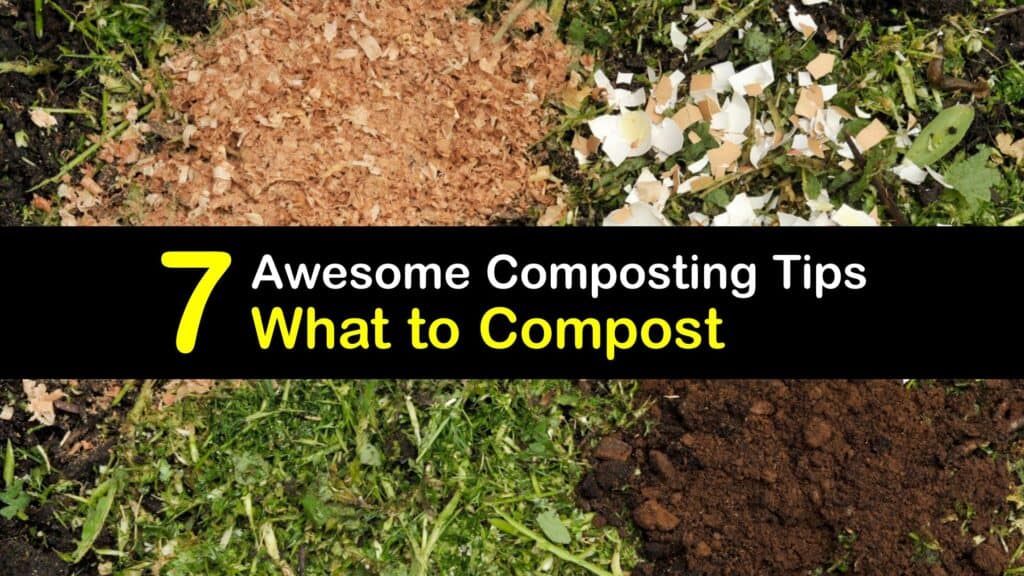You can recycle many items in a compost heap that you usually toss into the trash. However, if you’re using a compost bin for the first time, you may find the composting process confusing. We put together a list of compostable items to help get you started, explain what happens to the material when you compost it, and give tips for using finished compost around the home.
Starting a compost pile is a fantastic way to reuse leftover organic waste and turn it into a rich fertilizer, or what farmers call “black gold.” Composting turns compostable items into a natural resource, saving you money while sending less material to the landfill.
While composting is pretty straightforward, there is a right and wrong way to go about it, and not everything is suitable for adding to compost bins. As much as we’d love to recycle everything, some items are hazardous. Understanding what’s safe to compost and what’s not is vital. It’s equally essential to balance the pile with greens and browns.

Composting With the Right Materials
Learn the difference between green and brown materials, which items are great for composting, and which ones to avoid. Asking what is compostable is an important first start for your compost pile or bin.
You may want to begin on a smaller scale. Start with a small compost bin for your kitchen to see how practical it is for you. Then, work up to a larger bin or pile in the yard. Find examples of ways to use the composted material for the lawn and garden.
What Is Compost?
Composting is a common practice, allowing you to turn leftover waste and organic material into natural fertilizer. Learn what compost is, ways to compost meat, and which nutrients it provides to your plants.

Compost
Compost is a rich substance that combines ingredients like yard waste, food scraps, and other natural matter. Also, you can compost hair and other types of waste from your home.
This material adds nitrogen, potassium, phosphorus, and other nutrients to the soil, which plants take into their roots, stems, and leaves, providing them with better leaf and fruit production. There are many ways to compost potato peels, including a compost pile or heap, compost bin, and compost tumbler.
What Is the Composting Process?
There is more to composting than tossing in a few scraps now and then. There is a process the materials have to go through to ensure they change from food waste and yard scraps into finished compost.
After adding the proper amount of compostable materials from your green and brown compost list, the materials decompose. It is important to know the difference between green vs brown compost. The browns add carbon, the greens provide nitrogen, and the two work together with air and water to create a natural fertilizer.
It’s wise to break up the materials into small pieces since smaller pieces break down faster. Mesophilic, thermophilic, and curing are three distinct stages of composting.
First, the materials quickly begin to decompose and heat up. The temperature increases and organic wastes break down over a couple of weeks. Finally, the activity cools as the materials reach maturity, which is the longest stage.
Green and Brown Compost List
It’s easy to assume that you can throw any organic matter into the composting bin, but compost requires a balance of browns and greens to produce fertilizer. Read through this green and brown compost list to find ways to compost wood ashes, seaweed, and even pine needles to get you on the right track.
Greens are materials high in protein and nitrogen, including food scraps, grass clippings, perennial and annual plant material, and seaweed. You can compost bread in the green compost area, as well. These items help microorganisms multiply quickly and heat the compost, and they are excellent for adding to the green bin.
Browns are carbon-rich materials like dry leaf litter, twigs, tree bark, pine needles, hay, wood ash, corn stalks, and sawdust. Composting egg cartons that are cardboard also works. The main job of brown material is as a food source for soil-dwelling organisms as they work with microbes to break down the pile.
Compost Materials List for Organics Recycling
Materials that were once alive, including the foods you eat, are considered organic waste, so you can definitely compost chicken bones. Many of these items are perfect for composting. Here is a compost materials list of food items for organic recycling.
The best food scraps to add to the compost pile green cart are leftover raw or cooked fruit and vegetables, such as apple, carrot, potato, and banana peels. Can you compost pumpkins? Leftover pumpkin can be included in your compost heap.
However, other food items are good for composting, like nuts and grains, used coffee grounds and tea leaves, and eggshells. However, since food scraps are greens, it’s vital to balance them with browns to prevent overheating.
Surprising List of Compostable Items
While things like grass clippings, leaves, banana peels, and eggshells may seem obvious, some unexpected materials are also compostable. The list of things you can compost in your home may surprise you.
There are more items around the house to toss into the compost than you think. Composting cardboard, dryer lint, toilet paper rolls, paper towel rolls, tea bags, newspapers, coffee filters, food soiled paper, paper bags, hair and fur, cotton balls, and cotton fabrics is all beneficial.
While these materials may seem strange, another item on the compost materials list is most surprising – animal feces and horse, goat, cow, and poultry manure all compost easily. The process to make goat manure compost is quite simple, and it can then be turned into garden fertilizer.
Are There Items That Are Bad for Composting?
It’s helpful to keep a list of what to compost on hand to ensure you get the most out of the composting process, but it’s just as necessary to have a list of items that are not compostable. Getting started with composting at home includes avoiding these things in the compost pile.
While many food scrap types are acceptable for composting, avoid adding dairy and meat products, baked goods, and oily or greasy food since these items attract pests and may alter the decomposition process.
Pet and human waste, treated sawdust and yard waste, and glossy paper are additional things to keep away from the compost heap. The best way to determine if it’s safe for composting is to consider if the item is treated with any chemical. If it is, do not put it into the compost pile.
Ways to Use Compost Around the Home
Once you know what to compost and have a bin full of fertilizer, it’s time to put the material to work. There are some common ways to use compost around the home.
While there are many uses for compost, top dressing, fertilizing, and amending the soil are the top three. Sprinkle some compost around the base of your plants to fertilize them, add a thin layer of the material to the lawn and aerate it, or work a couple of inches of compost into the top several inches of soil before starting a new garden.
Composting is the perfect way to let nature turn waste into a resource, whether you use compostable bags, compost bins, or compost tumblers. However, adding the proper materials is vital to ensure you get safe and chemical-free compost.

We hope that our list of compostable items ensures that you end up with finished compost, and we’d love it if you’d share our composting material list with your family and friends on Facebook and Pinterest.